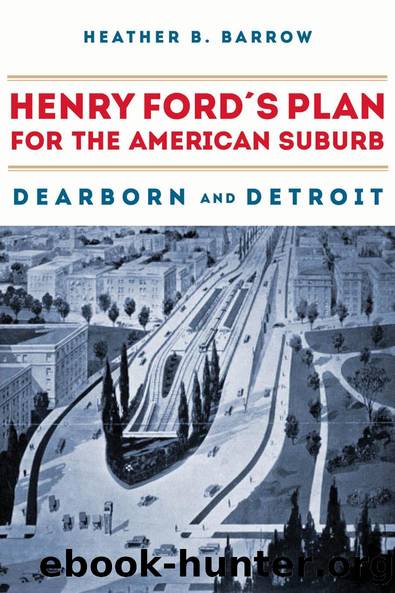Henry Ford's Plan for the American Suburb by Heather Barrow

Author:Heather Barrow [Barrow, Heather]
Language: eng
Format: epub
Tags: History, United States, State & Local, Midwest (IA; IL; IN; KS; MI; MN; MO; ND; NE; OH; SD; WI), 20th Century, Political Science, Public Policy, City Planning & Urban Development
ISBN: 9781501757143
Google: Kf_-DwAAQBAJ
Publisher: Cornell University Press
Published: 2018-10-29T01:44:02+00:00
I was twelve years old when Pat Brooks heard about the money Ford was paying. He went up first, then brought us up to Detroit. We moved in with some of our kin in MacComb Street. It was kind of crowded there, but the house had toilets indoors and electric lights. Down in Alabama we had outhouses and kerosene lamps. My stepfather got a job with Ford, and we got a place of our own in a frame tenement in Catherine Street.22
Nonetheless, Fordâs commitment to preserve a hierarchy based on race ultimately limited the advancement of African Americans.23
A few of Detroitâs African Americans in search of a better life moved into white neighborhoodsâwith confrontations, even violence, following. NAACP officer Walter White reported that âa colored woman and her family were notified by certain white people to vacate the home which they had recently purchased.â After not one but two stonings on the house, âthe colored women fired at the mob.â She was later acquitted. A black physician was threatened when he moved into a new house on King Avenue, but after announcing âhe was going to protect his home and his family, if necessary, [he received] no further trouble.â In an incident with a less fortunate outcome, a home on Spokane Avenue bought by an African American man was attacked by a mob, which âbroke into his home, smashed a great deal of the furniture, loaded the rest of it on a van and carried it back to this manâs former home.â According to White, ânothing was done by the police to prevent this attack.â24
These incidents culminated in the 1925 case of Ossian Sweet, an African American doctor and graduate of Howard University, who bought a house with a racially restrictive deed attached.25 The white woman who sold him the house received threats, which prompted Sweet to notify the police of his moving-in date and to arm himself.26 When he moved in, a mob formed outside his house, and on the second night, its members, now up to six hundred strong, became violent, stoning the house.27 The ten police officers present did nothing to intervene. Then, from the Sweet house, gunfire was shot into the crowd, killing one and wounding another, which resulted in the arrest of everyone inside.
The Sweet case became a lightning rod for racial issues in Detroit, as evident in the letter that Mayor John Smith sent to the Detroit Free Press in which he pointed the finger of blame in all directions. The rise in prejudice he attributed to a ârevival of the Ku Klux Klan,â which he referred to as a âcowardly campaign.â The police, meanwhile, had failed to provide âlegal protections to all persons, regardless of creed or color.â At the same time, however, he faulted African Americans who moved into predominately white neighborhoods, declaring, âI believe that any colored person who endangers life and property, simply to gratify his personal pride, is an enemy of his race as well as an incitant of riot and murder.
Download
This site does not store any files on its server. We only index and link to content provided by other sites. Please contact the content providers to delete copyright contents if any and email us, we'll remove relevant links or contents immediately.
| African Americans | Civil War |
| Colonial Period | Immigrants |
| Revolution & Founding | State & Local |
Cat's cradle by Kurt Vonnegut(15262)
Pimp by Iceberg Slim(14437)
4 3 2 1: A Novel by Paul Auster(12332)
Underground: A Human History of the Worlds Beneath Our Feet by Will Hunt(12054)
The Radium Girls by Kate Moore(11976)
Wiseguy by Nicholas Pileggi(5711)
The Fire Next Time by James Baldwin(5386)
Perfect Rhythm by Jae(5359)
American History Stories, Volume III (Yesterday's Classics) by Pratt Mara L(5276)
Paper Towns by Green John(5141)
Pale Blue Dot by Carl Sagan(4960)
A Higher Loyalty: Truth, Lies, and Leadership by James Comey(4908)
The Mayflower and the Pilgrims' New World by Nathaniel Philbrick(4461)
The Doomsday Machine by Daniel Ellsberg(4452)
Killers of the Flower Moon: The Osage Murders and the Birth of the FBI by David Grann(4410)
The Sympathizer by Viet Thanh Nguyen(4344)
Too Much and Not the Mood by Durga Chew-Bose(4305)
The Borden Murders by Sarah Miller(4278)
Sticky Fingers by Joe Hagan(4148)
